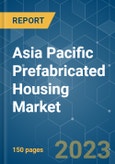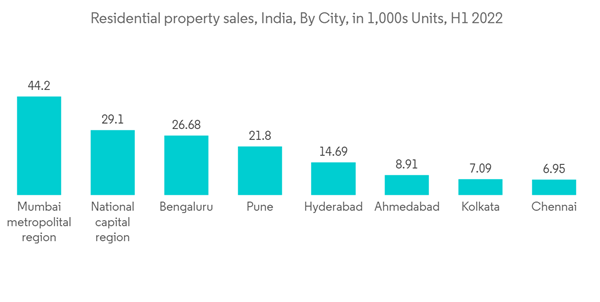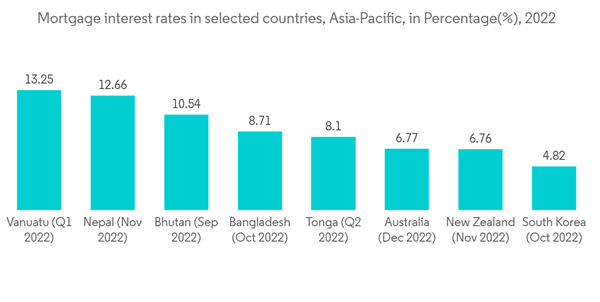Key Highlights
- The emphasis on cost savings is a major driver of the single-family modular and prefabricated housing construction market's growth. Modular design can reduce project deadlines by up to 50% and costs by 20%. They result in higher productivity and lower labor costs associated with purchasing units along a production line. Building Information Modeling (BIM) implementation in modular construction is a new trend in the single-family modular and prefabricated housing construction market. Building Information Modeling (BIM) is a ground-breaking method for designing, constructing, and managing construction models. Transportation risks are a major factor influencing the growth of the single-family modular and prefabricated housing construction market. Because modules are manufactured in a factory away from the worksite, they must either be transported specifically to the construction site or assembled in a surrounding venue and then set up.
- The ability to complete projects faster than traditional on-site buildings is a major factor driving the growth of the modular construction industry. The global modular construction market is expected to grow due to a growing emphasis on sustainability, quality, worker safety, and the ease of disassembling, refurbishing, and relocating modular structures. The lack of reliability in modular construction in earthquake-prone regions is a major restraint that may have a negative impact on the global modular construction market. Increased government rules and policies, as well as a renewed focus on upgrading healthcare infrastructure, are expected to create opportunities in the global modular construction market. However, a lack of awareness about modular constructions is expected to stymie market growth.
- Residential and commercial real estate demand is expected to rise significantly through 2030. Modular and prefabricated construction is expected to be more efficient in terms of construction time. Recent modular projects, for example, have a proven track record of reducing project timeframes by 20-50%. This saves a significant amount of money, roughly 20% of the project's cost, as well as man hours that can be put to better use. Metropolitan areas will house approximately 68% of the world's population by 2050, according to the United Nations. Furthermore, the World Bank estimates that 300 million new housing units will be needed by 2030 to house approximately three billion people. The growing use of modular and prefabrid building systems in single-family and multifamily housing in Asia and ASEAN countries is predicted to boost the market growth.
- The successful establishment of the modular and prefabricated construction markets in developed regions is attracting a large number of investors in developing regions, and the growing construction sector is driving business statistics. The construction industry is introducing new technologies, such as eco-friendly products and energy-absorbing materials, including micro dwellings, to improve business processes, such as production productivity, accuracy, and logistics, resulting in a focus on energy efficiency. Because of the cost advantages of modular buildings and rapid urbanization, the sector will grow rapidly. The growing demand for mobile and custom homes will drive market growth. The rising cost of manufacturing and raw materials is driving up demand for modularized buildings. Because of the constantly expanding working population, new opportunities will emerge in the coming years.
Asia Pacific Prefabricated Housing Market Trends
Increasing Demand for Housing Driving the Market
Housing markets in the Asia-Pacific region may be at a crossroads. Housing booms that were prevalent before and during the pandemic may be about to reverse amid stretched housing price valuations and rising interest rates after experiencing frequent and pronounced housing cycles over the past decades. Housing market developments are critical for households and policymakers at the current macroeconomic juncture because housing is the single most important household asset, and mortgages account for a large portion of household liabilities. Housing busts can have a significant impact on the health of economies and household livelihoods. And, while some housing markets have seen rapid price increases for an extended period, increasingly wealthy housing price valuations have priced out many low-income households. The ongoing rise in mortgage rates in many countries will likely exacerbate affordability concerns.Government policies can be a good predictor of future growth. For example, Chinese and Hong Kong policies are now supporting the housing sector to increase supply and relieve housing cost pressures. The Chinese government has also been largely supportive of the development of e-commerce. These policies, in our opinion, have the potential to accelerate growth in logistics and multifamily real estate. On the private side, it appears that there are still some opportunities to develop industrial logistics in prime Chinese markets at an estimated 7-8% cost yield, which provides a good buffer for riding out the cycles. Demand for multifamily housing appears to be strong as well, with positive rental growth and development margins. While industrial logistics and multifamily housing remain largely attractive sectors in Asia-Pacific, construction and operating costs are nonetheless rising across the board; thus, investors may wish to avoid long-term fixed leases where revenues are capped.
Ease of Construction and Low Cost Driving the Market
The housing sector has remained a bright spot in the Asia-Pacific region over the last two years. Because of low interest rates and a shift in housing preferences toward larger homes, there has been an increase in demand for new constructions and home improvements. However, as interest rates rise and inflation rises, the residential sector is expected to bear the brunt of the impact in short to medium term. The crisis engulfing Australia's construction sector worsened in Q2 2022. Many companies went into administration or liquidation because they owed millions of dollars to suppliers and subcontractors.China's 'dual carbon' goals (also known as the 30-60 targets: 2030 carbon peak and 2060 carbon neutral) have the potential to provide significant growth opportunities for the Chinese construction sector. Reduced carbon emissions in the construction sector are critical to China's carbon peak and neutrality targets. Green and dual carbon technologies can also provide significant value-added benefits to the construction industry. The construction industry relies heavily on government policy to reduce carbon emissions. Digital transformation is a major driving force in China's construction industry reform. Leaders believed that digitalization was required to improve efficiency, lower costs, and keep up with the times. While larger organizations have made significant progress in adopting digital tools and practices, small and medium-sized businesses have not. Building information modeling and model-centric working are needed to improve productivity and decision-making.
The popularity of modular construction varies greatly across the world, whether in the form of 2-D panels that require on-site assembly or fully constructed 3-D units built in off-site factories. In some places, such as the United States, adoption is still in its early stages, whereas in others, such as Scandinavia and Japan, modular construction is well established. The primary drivers are labor dynamics, specifically construction labor shortages and persistently high housing demand. Following these are determining factors such as local site constraints, supply chain and logistics, quality perception, material access, and regulations.
Asia Pacific Prefabricated Housing Industry Overview
The Asia-Pacific Prefabricated Housing Market is highly competitive and fragmented, with a large number of local and regional and a few global players penetrating the market. Major players in the market include Daiwa House Industry, Sekisui House, Ichijo, Panasonic Homes, and Toyota Housing Corporation. The market is expected to grow during the forecast period due to the increase in prefab construction building investments and upcoming major projects in the region.Additional Benefits:
- The market estimate (ME) sheet in Excel format
- 3 months of analyst support
This product will be delivered within 2 business days.
Table of Contents
1 INTRODUCTION1.1 Study Assumptions
1.2 Scope of the Study
2 RESEARCH METHODOLOGY
2.1 Analysis Methodology
2.2 Research Phases
3 EXECUTIVE SUMMARY
4 MARKET INSIGHTS
4.1 Current Market Scenario
4.2 Technological Trends
4.3 Insights into Supply Chain/Value Chain Analysis of the Prefabricated Housing Industry
4.4 Cost Structure Analysis of the Prefabricated Housing Industry
4.5 Impact of COVID-19 on the Market
4.6 Insights on Different Types of Materials used in Prefabricated Housing Construction
5 MARKET DYNAMICS
5.1 Drivers
5.2 Restraints
5.3 Opportunities
5.4 Porter's Five Forces Analysis
5.4.1 Bargaining Power of Suppliers
5.4.2 Bargaining Power of Consumers / Buyers
5.4.3 Threat of New Entrants
5.4.4 Threat of Substitute Products
5.4.5 Intensity of Competitive Rivalry
6 MARKET SEGMENTATION
6.1 By Type
6.1.1 Single Family
6.1.2 Multifamily
6.2 By Country
6.2.1 China
6.2.2 Japan
6.2.3 India
6.2.4 Rest of Asia-Pacific
7 COMPETITIVE LANDSCAPE
7.1 Overview
7.2 Company Profiles
7.2.1 Daiwa House Industry
7.2.2 Sekisui House
7.2.3 Ichijo
7.2.4 Panasonic Homes
7.2.5 Toyota Housing Corporation
7.2.6 Ausco Modular Construction
7.2.7 Shanghai Star House
7.2.8 Archiblox
7.2.9 Anchor Homes
7.2.10 Aussie Modular Solutions*
8 MARKET OPPORTUNITIES AND FUTURE TRENDS
9 APPENDIX
9.1 Marcroeconomic Indicators (GDP breakdown by sector, Contribution of construction to economy, etc.)
9.2 Key Production, Consumption, Exports, and Import Statistics of Construction Materials
Companies Mentioned (Partial List)
A selection of companies mentioned in this report includes, but is not limited to:
- Daiwa House Industry
- Sekisui House
- Ichijo
- Panasonic Homes
- Toyota Housing Corporation
- Ausco Modular Construction
- Shanghai Star House
- Archiblox
- Anchor Homes
- Aussie Modular Solutions*










